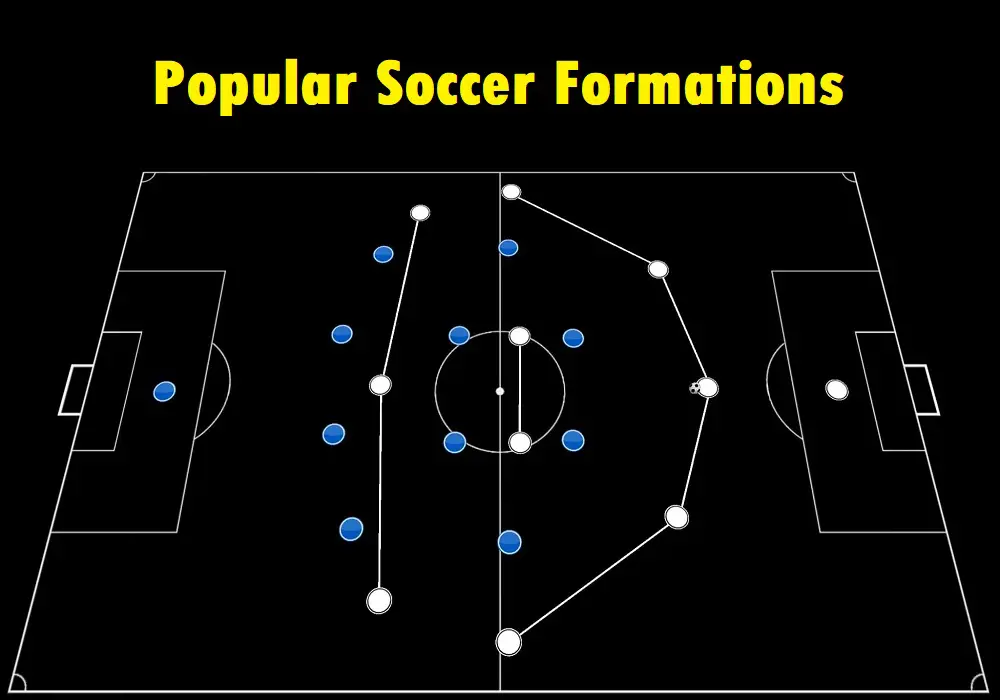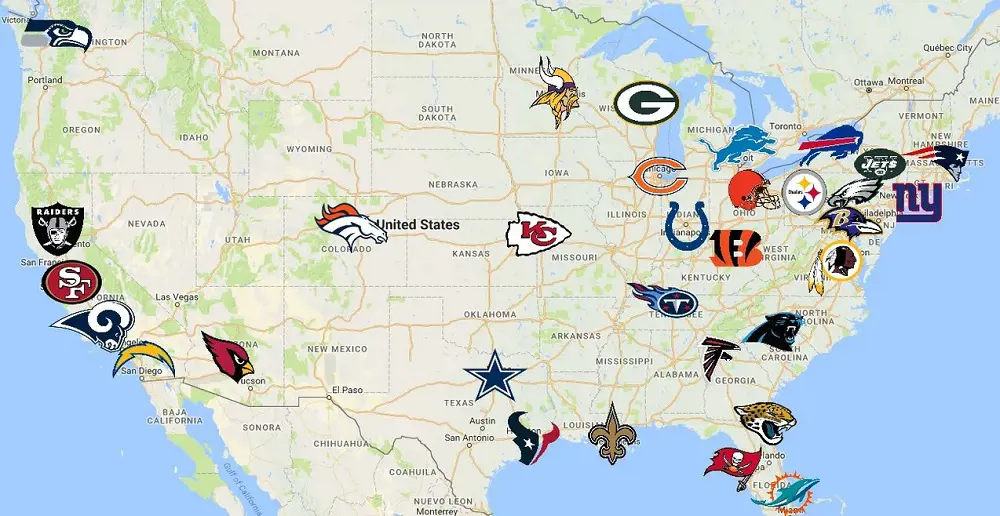Formations in soccer refer to how players are tactically positioned on the field. It's an important part of team strategy, impacting offensive and defensive tendencies.
They are usually represented by numerals separated by dashes, denoting the number of players in each line from the goalkeeper to the forwards.
There are many different formations in soccer, but the most used is 4-3-3 in recent times. Teams like Manchester City, Bayern Munich, and Liverpool have achieved huge success with variations of the 4-3-3
Hence, it also depends upon coaches to coaches and the opposition team, which formation would work better and suitable.
4-3-3

The 4-3-3 football formation consists of four defenders, three midfielders, and three strikers. Defenders normally comprise two center-backs and two full-backs, providing defensive stability.
A holding midfielder and two central midfielders balance defensive and offensive responsibilities in the midfield trio.
The three attackers comprise a center striker surrounded by two wingers, promoting offensive diversity and width. Quick transitions, smooth ball movement, and attacking penetration are all emphasized and it is possibly the best soccer formation.
4-4-2

Four defenders, four midfielders, and two attackers make up the 4-4-2 formation. It has a solid defensive backline with two center-backs and two full-backs.
The midfield is made up of two center and two wide midfielders, who provide offensive support as well as defensive solidity. The two strikers work together upfront, alternating between target-man and supporting positions.
The 4-4-2 formation, known for its simplicity and balance, promotes collaboration, direct play, and the ability to exploit both central and wide areas.
4-5-1

Four defenders, five midfielders, and a single striker make up the 4-5-1 football formation. Similar to the previous two formations, for defensive stability, it deploys two center-backs and two full-backs.
The midfield is composed of three central and two wide midfielders, resulting in a strong presence in the middle of the pitch. The offense is led by a lone striker, who is often a target man.
This formation emphasizes defensive resilience, midfield control, and effective counterattacks. It's especially useful for teams aiming to take the lead, maintain possession, and limit the opponent's offensive options.
4-2-3-1

One of the variation soccer formations 4-2-3-1 consists of 4 defenders, 2 defensive midfielders, 3 attacking midfielders, and a lone striker. It uses a back four with two holding midfielders on defense.
The three attacking midfielders form a line behind the lone striker, allowing for more offensive creativity.
This setup provides a strong defensive foundation, midfield control, and attack flexibility thanks to a dynamic front four. It is popular because of its balance, which allows teams to easily transition between defense and offense.
5-4-1

The 5-4-1 is one of the most defensive soccer formations as five defenders form a formidable backline, often with three central defenders providing central coverage and two wing-backs patrolling the flanks.
Among four midfielders, two defensive midfielders sit deep, acting as shields in front of the backline and winning back possession. The other two are wide midfielders, supporting the wing-backs defensively and offering attacking width.
The lone becomes the sole offensive focal point, holding up the ball, creating space for teammates, and finishing scoring opportunities.
4-1-3-2

Four defenders, one defensive midfielder, three central midfielders, and two attackers make up the 4-1-3-2 football formation. It has two center-backs and two full-backs on defense, with a holding midfielder acting as a shield.
The central midfield trio consists of one deeper playmaker and two more advanced midfielders. This formation, with two strikers up front, tries to keep a compact shape, control the midfield, and allow for speedy build-up play.
It offers adaptability in both offensive and defensive phases, striking a balance between defensive stability and offensive dynamism.
For 8v8 soccer formations, 2-3-2 could be the best formation.
4-1-2-1-2 Diamond

Four defenders, a single defensive midfielder at the base of the diamond, two central midfielders, an attacking midfielder, and two forwards comprise the 4-1-2-1-2 Diamond football formation.
Two center-backs and two full-backs make up the defensive structure, while a holding midfielder, central midfielders, and an advanced playmaker make up the diamond midfield.
This shape promotes ball retention, rapid transitions, and coordinated center attacks. The diamond shape allows for numerical superiority in the middle of the pitch, allowing for offensive creativity as well as defensive stability.
Likewise, for 6v6 soccer formations, 2-2-1 plays a similar role to 4-1-2-1-2 in 11v11 and is one of the best u10 soccer formations.
3-5-2

Three defenders, five midfielders, and two strikers make up the 3-5-2 football formation. It deploys three center-backs to provide a strong backline.
The midfield is made up of two central midfielders who are flanked by wing-backs who operate in wider areas. This system promotes a strong presence in the middle, allowing for both defensive firmness and offensive support.
The two strikers up front collaborate to form a versatile attacking combo. The 3-5-2 is noted for its adaptability, allowing teams to control the middle of the pitch, exploit wide areas, and modify their playing style based on the game's tactical requirements.
5-3-2

Five defenders, three midfielders, and two attackers make up the 5-3-2 football formation. To bolster the backline, it deploys three center-backs and two wing-backs.
The midfield trio consists of a center midfielder and two box-to-box players who provide defensive and offensive support. By crowding the middle zones, this formation seeks defensive solidity.
The two strikers up front collaborate to allow for rapid counter-attacks. The 5-3-2 is ideal for teams that want to retain a compact defensive shape while still creating opportunities for attacking transitions through a strong defensive foundation.
3-2-4-1

Three center backs form a fortress, flanked by two wing-backs who charge like knights. Four midfielders control the land, two defending, two attacking, like rooks ready to pounce.
One lone striker stands as the king, waiting to claim the goal. This 3-2-4-1 formation: solid defense, midfield dominance, surprise attacks from the wings, and a lone hero waiting to claim victory!
Hence, it is appropriate for teams that want to dominate possession, control the tempo of the game, and create scoring chances with a lone striker leading the line.
Classic 2-3-5

In the bygone era of football, where artistry trumped efficiency, the Classic 2-3-5 reigned supreme. The classic 2-3-5 football system, which was popular in the early days of the game, consists of two defenders, three midfielders, and five forwards.
These unique soccer formations explained below:
It employs two full-backs and three half-backs who function as a hybrid of modern-day defenders and midfielders. Two wingers, two inside forwards, and a center-forward are among the five forwards.
This attacking setup emphasizes a direct and expansive style of play, with numerical superiority in the attacking third being prioritized.
2-3-2-3

Two defenders, three central midfielders, two wide midfielders, and three strikers make up the 2-3-2-3 football formation, which is among different soccer formations.
It focuses on two center-backs to defend, while three central midfielders give assistance and control.
Wide midfielders contribute to both the defensive and attacking phases of the game. The formation employs two wingers and a central striker offensively, resulting in a potent attacking three.
4-2-4

Four defenders, two defensive midfielders, and four forwards make up the 4-2-4 football formation. Defensively, it has two center-backs and two defensive midfielders.
The variation features four attacking players, including two wingers and two central strikers. The 4-2-4 formation, known for its emphasis on attacking capability, promotes offensive firepower, wide play, and quick transitions.
It frequently foregoes midfield control in favor of direct and aggressive attacking techniques, making it a daring and adventurous tactical option.
2-3-3 could be the ideal setup for 9v9 soccer formations.
4-4-1-1

Four defenders, four midfielders, one attacking midfielder/central forward, and one striker make up the 4-4-1-1 football formation. It uses a typical back four defensively, while the midfield is evenly spread with width.
The offensive midfielder/central forward assists the lone striker, resulting in a fluid attacking partnership.
This formation is also one of the most used 11v11 formations, that tries for a balanced approach, with the attacking midfielder offering help for both defensive and offensive phases.


